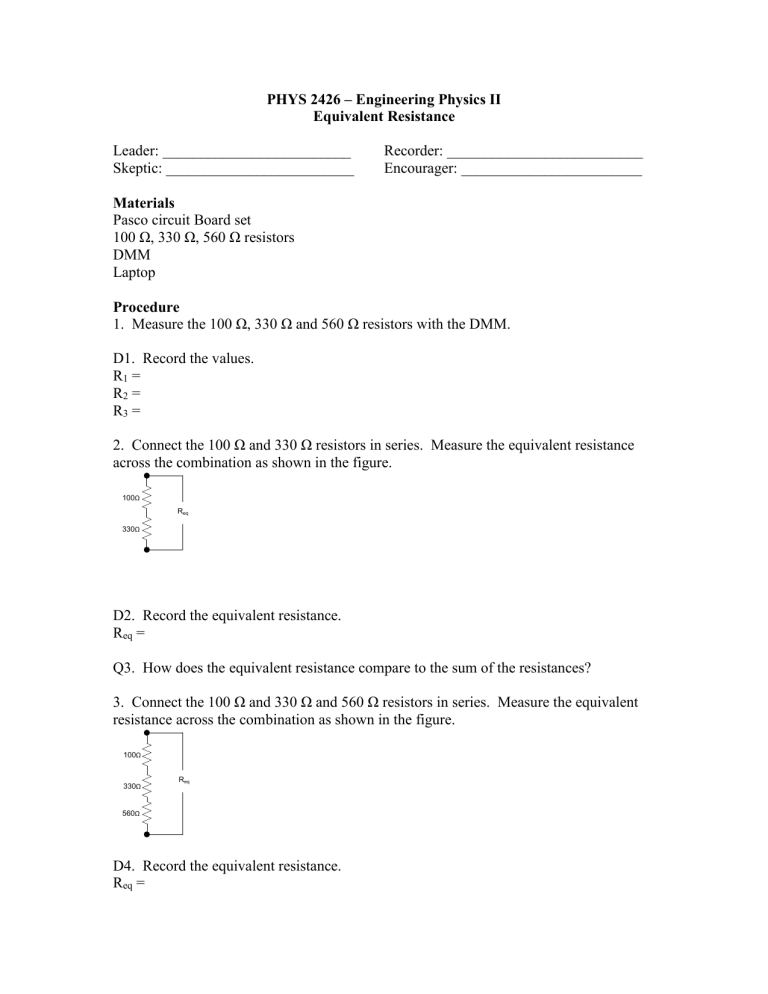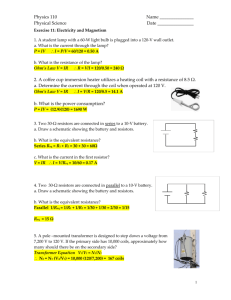PHYS 2426 – Engineering Physics II Equivalent Resistance Leader: _________________________

PHYS 2426 – Engineering Physics II
Equivalent Resistance
Leader: _________________________ Recorder: __________________________
Skeptic: _________________________ Encourager: ________________________
Materials
Pasco circuit Board set
100 Ω, 330 Ω, 560 Ω resistors
DMM
Laptop
Procedure
1. Measure the 100 Ω, 330 Ω and 560 Ω resistors with the DMM.
D1. Record the values.
R
1
=
R
2
=
R
3
=
2. Connect the 100 Ω and 330 Ω resistors in series. Measure the equivalent resistance across the combination as shown in the figure.
100 Ω
R eq
330 Ω
D2. Record the equivalent resistance.
R eq
=
Q3. How does the equivalent resistance compare to the sum of the resistances?
3. Connect the 100 Ω and 330 Ω and 560 Ω resistors in series. Measure the equivalent resistance across the combination as shown in the figure.
100 Ω
R eq
330 Ω
560 Ω
D4. Record the equivalent resistance.
R eq
=
Q5. How does the equivalent resistance compare to the sum of the resistances when resistors are connected in series?
The equivalent resistance of a network is the single resistor that will draw the same current through the potential source when connected to the same potential as the network.
Q6. How does the current compare at points a, b, and c in the figure below.
R1 a b
R2 c
R3
Q7. Use Kirchhoff’s voltage law to show that for the figures below, that
R eq
= R
1
+R
2
+R
3
.
R1
R eq
V V
R2
R3
4. Connect the 100 Ω and 330 Ω resistors in parallel. Measure the equivalent resistance across the combination as shown in the figure.
100 Ω 330 Ω R eq
D8. Record the equivalent resistance.
R eq
=
Q9. How does the equivalent resistance compare to the sum of the resistances?
Q10. How does the equivalent resistance compare to either the 100 Ω or 330 Ω resistor?
5. Connect the 100 Ω and 330 Ω and 560 Ω resistors in parallel. Measure the equivalent resistance across the combination as shown in the figure.
100 Ω 330 Ω 560 Ω R eq
D11. Record the equivalent resistance.
R eq
=
Q12. How does the equivalent resistance compare to the sum of the resistances?
Q13. How does the equivalent resistance compare to either the 100 Ω, 330 Ω, or 560 Ω resistor?
Q14. In the figure below what is the same across each resistor? Explain.
R1 R2 R3
Q15. Use Kirchhoff’s and Ohm’s laws to show that for the figures below, that
1/R eq
= 1/R
1
+ 1/R
2
+ 1/R
3
.
R eq
R1 R2 R3
S16. Find the equivalent resistance for the following networks.
10 Ω
10 Ω
15 Ω 15 Ω 20 Ω
10 Ω
20 Ω 10 Ω 10 Ω
20 Ω i) ii) iii)
If you have a single potential source, then finding the equivalent resistance is a very effective way to analyze a circuit. The general strategy is to find the equivalent resistance and use that to find the current provided by the source i = V/R eq
. Then other values can be found through use of Kirchhoff’s and Ohm’s laws.
S17. Use the equivalent resistance method to find the current through and the potential difference across each resistor. Check your work by building the circuit with the Circuit
Construction Kit at the PhET website phet.colorado.edu and measuring each value.
10 Ω 10 Ω
12V
5Ω 10 Ω
5Ω




